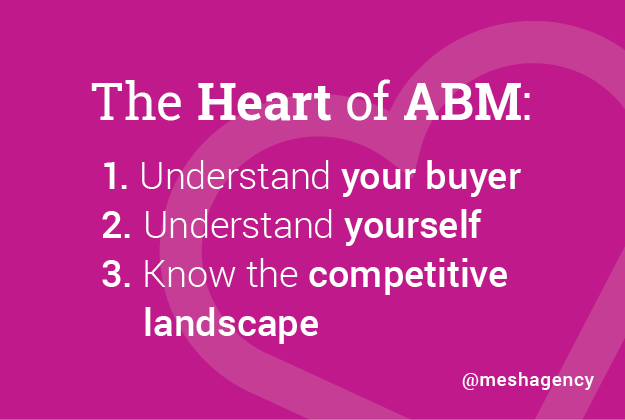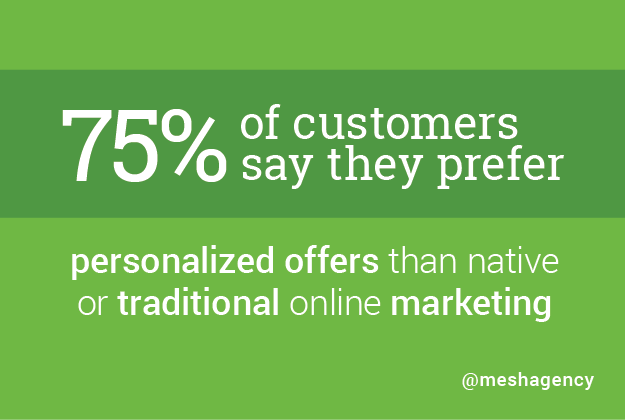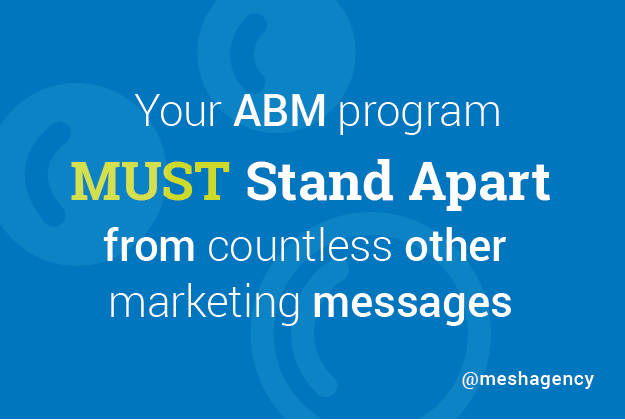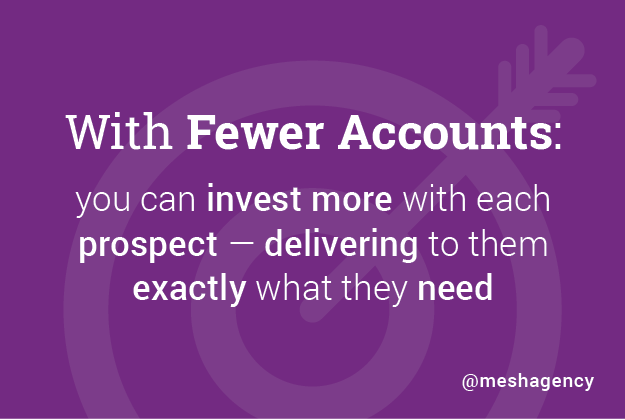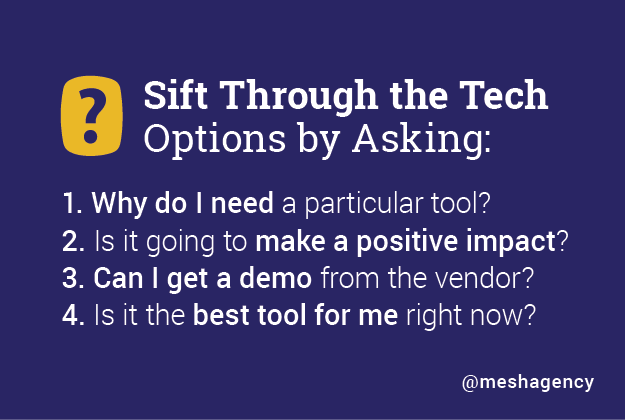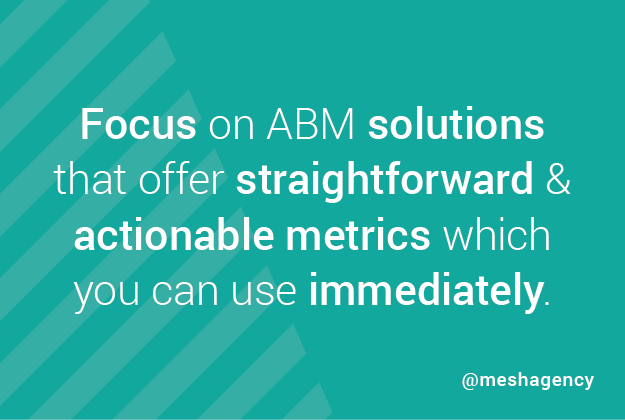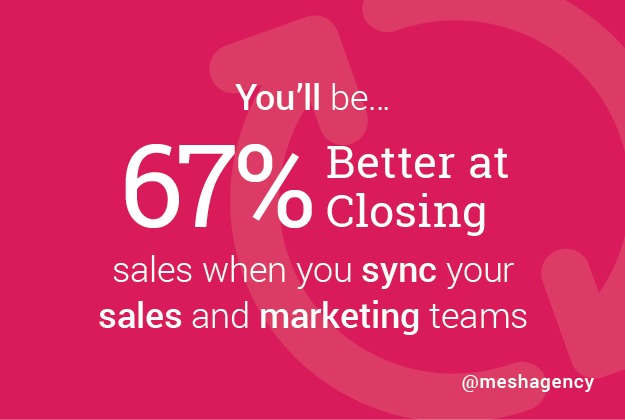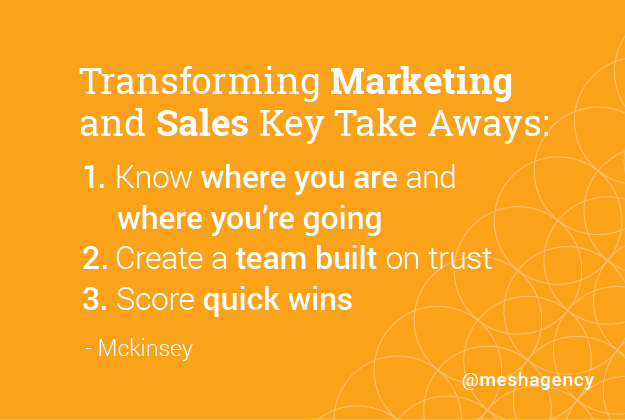Perhaps you’ve been in this situation—on the other side of the table. Just 2 weeks ago, I was sitting with a client. They’re a public technology company with offices around the world, and looking at a seismic shift in their industry—an industry that just doesn’t have a need for what they provide anymore. There’s no growth potential, and investors are looking at them with a wary eye. In doing a competitive analysis, they found that they’re not the only ones suffering—the entire market is stagnant.
Fortunately for them, there’s plenty of growth opportunity in untapped markets, and we’ve been tasked to position them for these future markets. But they face a common challenge—all of their case studies—their stories—their experiences—are focused on one industry, and that industry doesn’t translate well into other industries, so it’s tough to create analogous or broad case studies for them to jump into other markets.
So what are they to do?
Account-Based Marketing isn’t a buzzword or hype—it’s actually the lifeblood of integrated B2B sales and it drives a marketing strategy—particularly in cases where you’re looking to enter new, non-analogous markets with little or no social proof—like my friends in the story above.
While ABM is on the tip of everyone’s tongue and every AI company in the marketing space is beating us over the head with ebooks, white papers and video, the reality is that ABM works. The results are encouraging: According to ITSMA, “Almost 85% of B2B marketers who measure ROI agree that ABM delivers higher ROI than any other marketing approach.”
Another challenge is that—when everyone is doing it—how do you rise above, cut through the clutter, and make your offering stand out among a sea of competitors? Better yet—how do you level-up in this competitive marketing environment when there’s a lot to contend with? Budgeting considerations that strangle even the most creative approach, consumer behavior that’s dynamic in nature, and constantly evolving technology—all of these factors could make it hard for you to reach your business’ goals.
This is where ABM comes into play. If you want to outsmart your competitors, then you must wear a different hat. You can’t afford to cast a wide net with your marketing campaigns in order to appeal to as many of your target audiences. When you take the Account-Based Marketing approach, you’re focused on the specific needs and attributes of a particular account you’re targeting.
The heart of ABM is three-fold. First, you need to understand your buyer. Who is your ideal buyer profile? Second, you need to understand yourself—what specific problem are you solving for that particular customer? Lastly—and often overlooked—what is the competitive landscape? ABM puts strong demands on content marketers, and if you don’t know what your competitors’ content marketing strategies are, then you’re working with one eye blind.
Before I get too far into this, let’s answer one question first…
Is Account-Based Marketing Right for You?
ABM is all about targeted growth. If you’re ready to take control of your marketing efforts, be able to predict the direction of client’s future behavior and position your solution as the only and best path to their success, Account-Based Marketing is ideal for you.
The “long sales cycle” has become the norm—every CEO, VP of Sales and Marketing leader laments it—and is looking for a way to shorten it. Companies sometimes spend years developing content and marketing strategies that just don’t move the needle. So, instead of spinning your wheels creating general—yet valuable—resources that no one consumes, you can use ABM to realign your B2B marketing strategy. The results will overwhelm you.
As an Account-Based marketer, here are a few proven strategies and tactics you can implement right away to gain a foothold in your market:
1. Set Clear ABM Goals
What do you want to achieve? It’s not enough to expect “growth” when using ABM, you must be strategic and clear about it. While your competitors are so engrossed with the thoughts of dominating the market, you need to focus on increasing your ROI one step at a time.
Since ABM requires a mastery on account-level personalization (75% of customers say they prefer personalized offers) than native or traditional online marketing, bear in mind that it might cost you more money to implement it if you’re going to scale successfully.
More importantly, you’ve got to work on your goals for at least 1 year so you can be able to measure results based on the data collected.
Data compiled by Forbes revealed that 60% and 19% of users who implemented ABM for at least a year, reported a revenue increase of at least 10% and a revenue impact of 30% or more, respectively.
2. Run Creative Marketing Campaigns for Target Accounts
Do you want to be able to acquire high-value clients to your B2B business? Then, you’ve got to do it with style.
Since you’re targeting intelligent customers that are already overwhelmed with marketing messages, your ABM program MUST stand apart from the rest—and since you’re focusing on a few key accounts—you can do things that would be nearly impossible for other strategies to scale.
For example: did a target account recently go public? They need to file annual reports now. Maybe you could create a digitally printed short-run “annual report” as part of your campaign. Did one of your targets just win recognition from Deloitte’s Fast 500 (like one of ours did)? Jump on the “fast” metaphor and get their attention with a custom branded Micro RC Pocket Racer (I did this one year—blew the doors off).
Whatever it is, don’t be limited by online and digital solutions. The idea around ABM is that you can go guerrilla—and conduct highly targeted custom campaigns to get on your prospects’ radars, campaigns that you would never be able to do at scale.
3. Focus on a Smaller Set of Target Accounts
Your ideal customers are counting on you to deliver a personal and optimized experience at every stage of the customer journey.
Once you’ve built your target account list (i.e., companies you want to turn into customers), it’s time to make a smart move.
Let’s say you have 100 target accounts on your list, in traditional marketing, you might be tempted to pitch all of them or find ways to engage them, but in ABM, it’s a lot better to go with a smaller set of your target accounts and win them first before moving on to the next set.
According to The State of Pipeline Marketing 2016, conducted by Bizible, “Marketers using ABM are about 40% more likely to report alignment with their sales team compared to marketers that ignore ABM.”
With fewer accounts, you can invest more with each prospect—delivering to them exactly what they need. According to FlipMyFunnel.com, properly executing on an ABM strategy will lead you to “spend more time with fewer prospects, which will create a more lasting sales partnership and happier customers”. So don’t think that by addressing fewer prospects you’re going to be doing less work—you’ll just be spending more of your time with fewer, yet higher-quality, leads.
4. Understand the Purpose of Your Technology Stack
It takes a deliberate effort to establish a winning customer acquisition and retention strategy. Hence, you need to understand the role of technology when engaging in ABM.
The important thing is that you not be overwhelmed by all the ABM tools out there. There are new tools every day, and the key thing is to remember to “just do it”. Choose a tool that meets your needs and run with it.
One way to help sift through all the technical options you have is to ask yourself a few questions. Why do you need a particular tool? Is it going to make a positive impact on your bottom line, or are you just adding it to your technology stack because it feels shiny and new? Ask the vendor for a demo and get a good sense of how the tool fits into your strategy. If it doesn’t fit in—or make it better—skip it for now.
Also, make sure you are working with a tech stack that is right for you. For example, Hubspot is a fine platform for small businesses, but not necessarily for public companies. On the other hand, not every company can use enterprise-focused Salesforce.
5. Make Decisions Based on Action-Oriented Insights
No matter how diced your data and metrics are, you need to be able to create actionable plans that will drive success with your target accounts when implemented. As I said earlier, you’re going to come across several ABM products and solutions. When making a choice, focus on Account-Based Marketing solutions that offer straightforward and actionable metrics which you can use immediately.
You should be able to get your arms around the following:
- Adding value to the decision-making process of the buying committee at your target account
- Measure Best-fit account engagement and advancement through the buyer journey—and more importantly—your pipeline
- Marketing handoff to Sales and total team alignment
Having these insights will help you drive your strategy and further your ABM efforts.
6. Get Your Perspective Clear on Marketing and Sales Alignment
Marketing and sales are dependent on each other. This shouldn’t be an afterthought but an essential part of the process for modern-day ABM. In fact, you’ll be 67% better at closing sales when you sync your sales and marketing teams.
Docurated has curated a few tips for aligning sales and marketing functions. These include:
- “Look at it from the eyes of the customer… we need to be customer-centered, customer-centric, customer-obsessed.” — @jill_rowley
- “Sales is the delivery vehicle for marketing’s message… every sales situation is unique… every time a rep — a good rep — gets in front of a client, they are pitching a slightly different story and value message based on all the great messaging and content that marketing has created.” – Alex Gorbansky
- “Account-Based Marketing is about aligning with outbound sales to generate the largest revenue… [marketers] produce the content and materials that help lure contacts at the company into deeper conversations with sales. While sales is effectively utilizing the moments of attention that marketing is engendering with their target prospects.” – Adam New Waterson
When you’re executing an ABM campaign, your mindset would of necessity be similar to sales, with a focus on target accounts and how you can generate sales consistently.
7. Build a Culture-Driven Team
Here’s the deal: every successful ABM campaign is rooted in culture. Just as your company focuses on setting up systems that aid in automating sales and marketing, what your team stands for must be clear.
In the real world, culture is a way of life. In Account-Based Marketing, culture is what bonds behaviors, decisions, preferences, and attitude.
If you’re just starting out in ABM, you may not have the resources to compete with the big dogs or build a robust ABM strategy, but you can define and drive a winning culture—your team and customers will thank you later.
Mckinsey has a great post on transforming marketing and sales, and here are three take aways I’ve always appreciated:
- “Know where you are and where you’re going” – everyone needs to recognize and build the case for change—and not just based on your gut, but with clear and insightful data.
- “Create a transformation team built on trust” – don’t just throw an initiative out there and put marketing or sales in charge of it—build a cohort of like-minded disruptors who have experience “reaching across the aisle”. Trust is more important than process here. If your teams don’t have trust in their ability to accomplish change with other groups—it will never succeed.
- “Score quick wins” – every team leading change needs to build momentum, so quick wins can help teams that are already feeling challenged to come together and continue the effort.
8. Competitive Analysis
This is probably the most overlooked aspect of ABM. Typically, teams focused on Account-Based Marketing spend their time identifying ideal customer profiles and creating content for the sales process. Then, after 6 to 12 months of effort, they’re not seeing the promised benefits of their efforts.
- Why? Well, according to Content Marketing Expert, Joe Pulizzi, content marketing is going to get weird. According to Joe:
- The effectiveness rate for B2B organizations actually went down (from 38 percent in 2015 to 30 percent in 2016.
- 91% of top performers are extremely or very committed to content marketing.
- 63% of organizations are extremely or very committed to content marketing.
The point of this is that EVERYONE is engaged in content marketing—and so the window of opportunity to connect and add value to your buyer is getting smaller and smaller.
To help with this, it’s important to not only understand your buyer and your own value—but also understand where you competitors are spending their time and money in developing content. For example, what topics do they “own”? Where are they strong—or weak? What content is your customer clamoring for—but your competitors are not focusing on creating?
Understanding this will help you add value to your buyer, your sales team, and ultimately to your business because you can then use competitive insights to determine where to invest your resources to create content that matters—and cuts through the clutter.
Wrapping Up and Next Steps
Account-Based Marketing is a critical—yet underutilized—strategy for any company looking to move into new markets. The agility, data focus and tactical capabilities inherent in ABM can help build new business in previously unattainable areas.
Are you leveraging ABM today? If so, where do you struggle? Is it a puzzle that you’re missing a few relatively minor pieces to, is it a black hole that you’re reluctant to explore, or are you hitting it out of the park?



